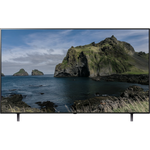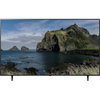A comparison of specs, key information, reviews, and best pricing from top retailers
Last updated -- hours ago | Report incorrect information
What we think

The PerfectRec TV team Learn more
Updated January 10, 2024·
If you're looking for a more budget-friendly option, the Hisense A65K is less expensive and offers good performance for gaming, news, and animation with decent picture quality in both dark and bright rooms. On the flip side, the LG A1 delivers superior overall picture quality, with excellent performance for sports, movies, and in dark rooms due to its OLED screen. However, the LG A1 costs more and may not be as bright as the Hisense in very sunny rooms. Give Feedback
this description is based on the product variant with some specs and product variant with some specs. At the time of writing, the variant with some specs cost some dollars and the variant with some specs cost some dollars.
Advantages of the Hisense A65K (LCD)
- The Hisense A65K (LCD) has no clear advantages over the LG A1 (OLED).
Advantages of the LG A1 (OLED)
- Very good for dark room
- Good for gaming
- Very good for movies & TV
- Very good for sports
- Very good for news, talk, & other TV
- Very good for cartoons & animation
- Very good for use as monitor
- Very good for upscaling
- Very good motion processing
- Very good viewing angle
- Very good reflections
Key differences
Picture Quality
6.7


8.2
5.64/10
CONTRAST
10.00/10
7.2/10
COLOR VOLUME SCORE
7.1/10
LED
PANEL TYPE
WOLED
VA
PANEL SUB-TYPE
WBC
The LG A1 (OLED) has very good picture quality, while the Hisense A65K (LCD) has only fair picture quality.
Movies & TV
5.9


8.9
5.64/10
CONTRAST
10.00/10
6.3/10
BLACK UNIFORMITY
10.0/10
7.0/10
UPSCALING
8.0/10
Yes
HDR10 SUPPORT
Yes
No
HDR10+ SUPPORT
No
Yes
DOLBY VISION SUPPORT
Yes
The LG A1 (OLED) is very good for movies & TV, while the Hisense A65K (LCD) is poor.
The LG A1 OLED TV offers excellent movie and cinematic TV watching due to its perfect contrast ratio, outstanding black uniformity, and superior viewing angles, which are crucial for deep blacks and consistent color when viewed from different positions. In comparison, the Hisense A65K LCD struggles with its limited contrast and less effective local dimming, resulting in less impressive blacks and overall picture quality in dark scenes, which are very important aspects when watching movies.
Sports
6.1


8.0
3.5/10
MOTION PROCESSING
8.0/10
60Hz
REFRESH RATE
60Hz
8.7/10
INPUT LAG SCORE
10.0/10
7.0/10
UPSCALING
8.0/10
7.2/10
SDR BRIGHTNESS SCORE
6.3/10
Yes
HLG SUPPORT
Yes
The LG A1 (OLED) is very good for sports, while the Hisense A65K (LCD) is only fair.
The Hisense A65K has a fair response time and motion processing which may lead to some blur during fast sports action and has a fair reflections handling, making it less ideal for bright rooms. The LG A1, with its excellent response time and very good handling of reflections, offers a clearer and less distracting viewing experience for sports, especially in rooms with ambient light, and its wide viewing angles ensure consistent picture quality when viewed from different seating positions.
Gaming
5.9


7.0
6.8/10
RESPONSE TIME SCORE
9.0/10
8.7/10
INPUT LAG SCORE
10.0/10
3.5/10
MOTION PROCESSING
8.0/10
18.0/100
GAMING LOCAL DIMMING
100.0/100
6.0/10
GAME HDR BRIGHTNESS SCORE
6.3/10
The LG A1 (OLED) is good for gaming, while the Hisense A65K (LCD) is poor.
The LG A1 (OLED) provides an excellent gaming experience due to its superior response time and the lowest input lag, making it responsive and smooth for fast-paced games. In contrast, the Hisense A65K (LCD) has only fair response time and very good input lag, which may lead to more noticeable delays and less fluid motion during gaming.
Cartoons & Animation
7.3


8.0
7.6/10
COLOR GAMUT SCORE
8.0/10
7.2/10
COLOR VOLUME SCORE
7.1/10
7.2/10
SDR BRIGHTNESS SCORE
6.3/10
8.1/10
COLORS OUT OF THE BOX SCORE
7.1/10
5.7/10
GRAY UNIFORMITY
9.2/10
The LG A1 (OLED) is very good for cartoons & animation, while the Hisense A65K (LCD) is good.
The LG A1 (OLED) offers vibrant and diverse colors right out of the box and a wide color gamut, making animations look more vivid and authentic. In contrast, while the Hisense A65K (LCD) delivers good color performance, it doesn’t quite match the LG's richness and range of colors.
News, Talk, & Other TV
6.7


8.4
7.2/10
SDR BRIGHTNESS SCORE
6.3/10
7.0/10
UPSCALING
8.0/10
The LG A1 (OLED) is very good for news, talk, & other TV, while the Hisense A65K (LCD) is only fair.
The LG A1 excels in watching news, talk shows, and other TV programs due to its OLED technology, which delivers perfect blacks and high contrast, essential for rich picture quality in various content, alongside very good upscaling capabilities for lower resolution sources. In contrast, the Hisense A65K, while providing decent performance with good upscaling, might not deliver the same level of picture quality with lower SDR brightness and no local dimming feature, which can result in less vivid colors and contrast in comparison.
Cost
$370


$1,100
$0
$500
$1,000
$1,500
$2,000
The Hisense A65K (LCD) has a price of $370 and the LG A1 (OLED) costs $1,100.

Let Us Help Find Your Perfect TV
Find your new TV
Key similarities
Bright Room
6.4


6.6
5.3/10
VIEWING ANGLE
8.8/10
7.2/10
SDR BRIGHTNESS SCORE
6.3/10
6.2/10
HDR BRIGHTNESS SCORE
6.1/10
6.6/10
REFLECTIONS SCORE
8.8/10
The LG A1 (OLED) and Hisense A65K (LCD) are both only fair for bright room.
The Hisense A65K performs well in SDR brightness, which helps in bright rooms, but its reflections handling is only fair, meaning it can struggle with direct light. In contrast, the LG A1 has fair SDR brightness, which is less ideal for bright rooms; however, it handles reflections very well, giving it an advantage in environments with lots of light sources.
Give feedback
We’re constantly working to improve.
How the Hisense A65K (LCD) and the LG A1 (OLED) compare to other TVs
Spec Comparison
| Hisense A65K (LCD) | LG A1 (OLED) |
GENERAL | |||
|---|---|---|---|
| Price | |||
$370 | $1,100 | ||
Brand | |||
Brand | Hisense | LG | |
Release Date | |||
Release Date | July 4, 2023 | March 3, 2021 | |
Full name | |||
Full name | 65A65K | OLED65A1 | |
Screen Size | |||
Screen Size | 65" | 65" | |
Screen Resolution | |||
Screen Resolution | 4K | 4K | |
TV FEATURES | |||
|---|---|---|---|
Operating System | |||
Operating System | Google TV | webOS | |
Sound Quality Score | |||
Sound Quality Score | 6.9/10 | 6.6/10 | |
NextGen Ready | |||
NextGen Ready | No | No | |
HDMI Ports | |||
HDMI Ports | 4 | 3 | |
Coax Ports | |||
Coax Ports | 1 | 1 | |
DISPLAY QUALITY SCORES | |||
|---|---|---|---|
Picture Quality Score | |||
Picture Quality Score | 6.8/10 | 8.3/10 | |
Bright Room Score | |||
Bright Room Score | 6.5/10 | 6.7/10 | |
Gaming Score | |||
Gaming Score | 5.9/10 | 7/10 | |
Movies & TV Score | |||
Movies & TV Score | 5.9/10 | 8.9/10 | |
Sports Score | |||
Sports Score | 6.1/10 | 8/10 | |
PHYSICAL | |||
|---|---|---|---|
Dimensions w/o Stand (H x W x D) | |||
Dimensions w/o Stand (H x W x D) | 32.8" x 57.2" x 2.9" | 32.7" x 57" x 1.8" | |
Dimensions with Stand (H x W) | |||
Dimensions with Stand (H x W) | 35.3" x 57.2" | 35.1" x 57" | |
Weight without Stand | |||
Weight without Stand | 36.4 lbs | 52.2 lbs | |
VESA Mount | |||
VESA Mount | 200 x 300 | 300 x 200 | |
DISPLAY | |||
|---|---|---|---|
Color Depth | |||
Color Depth | 10 bit | 10 bit | |
Black Frame Insertion | |||
Black Frame Insertion | No | No | |
Auto Low Latency Mode | |||
Auto Low Latency Mode | Yes | Yes | |
Contrast | |||
Contrast | 5.6/10 | 10/10 | |
Local Dimming | |||
Local Dimming | 3.5/10 | 10/10 | |
SOUND | |||
|---|---|---|---|
Speaker Setup | |||
Speaker Setup | 2.0 | 2.0 | |
Speaker Power | |||
Speaker Power | 20 W | 20 W | |
Dolby Atmos | |||
Dolby Atmos | Yes | Yes | |
DTS:X | |||
DTS:X | No | No | |
Shopping
Hisense A65K (LCD)
See more
Dig into reviews and images
Home Media Entertainment
Stratos Kampourogiannis | September 2023
"The A65K proved to be a rather capable TV that works great within its extreme limitations that its price dictates. It has great contrast, very low input lag and good color coverage. Add Google TV and a low price in the mix and you have an excellent low budget offering."
Get a great deal on the Hisense A65K (LCD) or the LG A1 (OLED)
About Hisense
Hisense, a Chinese TV manufacturer, entered the US market in approximately 2011 and has since acquired TV divisions from various companies such as Toshiba, Sharp, Hitachi, and NEC. Currently ranking as the fourth largest vendor in terms of sales volume, Hisense aims to capture a wide range of TV budget segments. They offer exceptional value with TVs that often outperform their competitors at similar price points, making them a compelling choice for consumers. In the US, they use Google TV as their smart TV software which provides the largest app selection and a very modern user interface, however it is not as user friendly as the software from other vendors.
About LG
LG, a prominent TV brand from Korea, has played a significant role in popularizing OLED TVs. OLED technology is hailed as the future of TV technology. Their TVs employ WebOS, a proprietary smart TV software that not only offers seamless functionality but also includes gaming-specific features, earning praise from players worldwide. Often regarded as the gateway to unparalleled viewing experiences, LG's mid-range OLEDs come highly recommended, making them a worthwhile investment for those willing to stretch their budget for superior quality.
Give feedback
We're constantly perfecting our model
TV guides you might be interested in
More comparisons for you
FAQs
FAQs about TVs
Why trust us
This information was produced and vetted by the PerfectRec TVs team. We are a product research and recommendation organization that meticulously reviews and evaluates the latest TV information and makes it digestible for you.
By the numbers
385
TVs evaluated
33,110
TVs stats compiled
21
Proprietary TVs ratings developed
121,530
Recommendations made
18,230
Consumer hours saved
About the TV team
Joe Golden, Ph.D
CEO and TVs Editor
Joe is an entrepreneur and lifelong electronics enthusiast with a Ph.D in Economics from the University of Michigan.
Jason Lew
Staff Expert & Software Engineer
Jason is a staff expert and software engineer that has been making laptop recommendations for 7 years and moderates one of the largest laptop subreddits.
Chandradeep Chowdhury
Staff Expert & Software Engineer
Chandradeep is a staff expert and software engineer and expert in televisions and monitors. He’s been making monitor recommendations for ten years.
Jaime Roldán
TVs Expert
Jaime is a Colombia-based TV expert. He is an electronics engineer with 8 years of experience in the telecom sector and has been making TV recommendations for 12 years.







